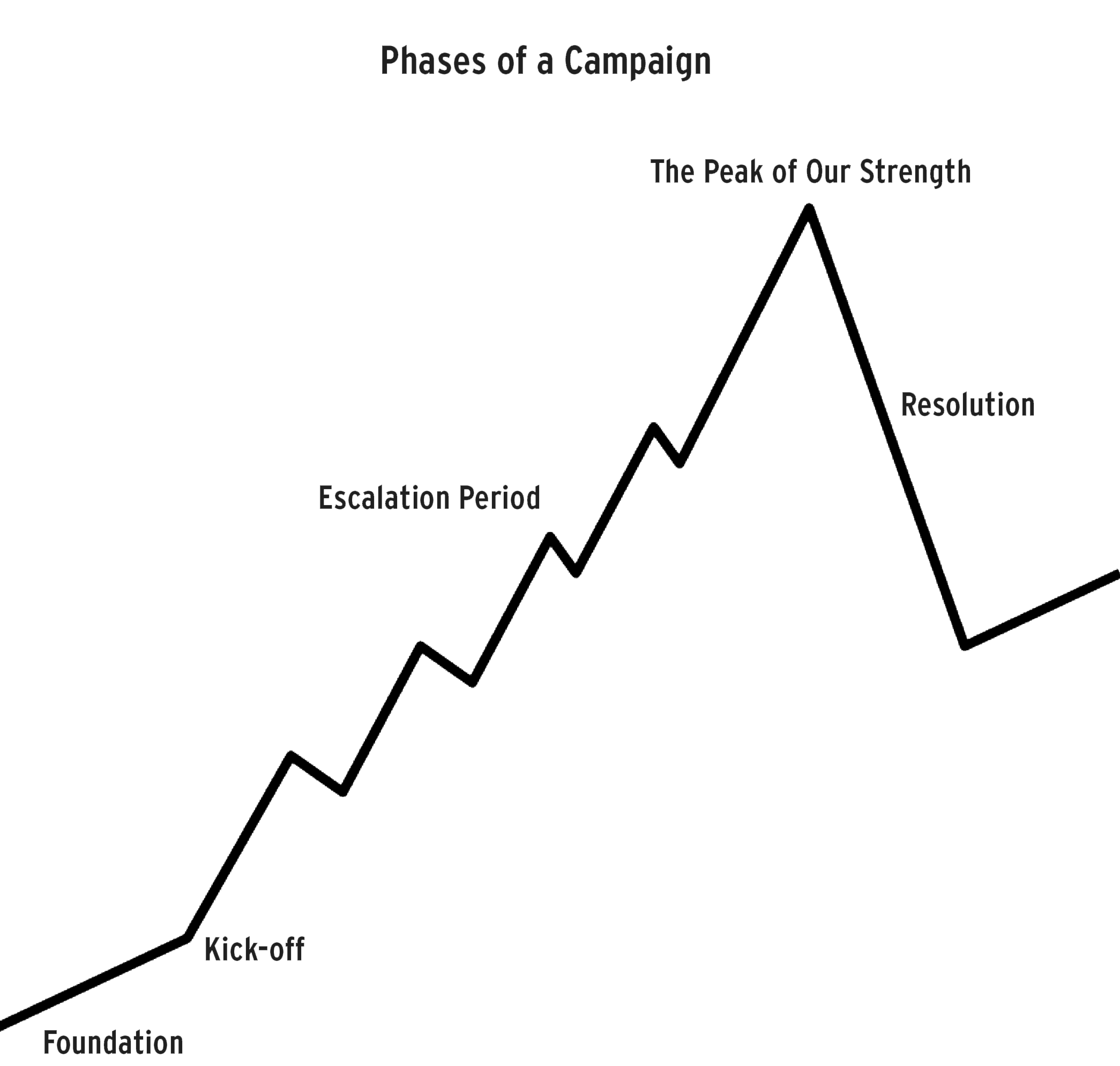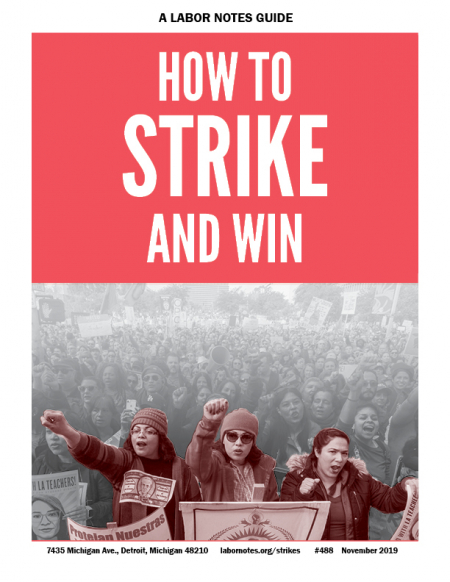Strike Timeline

When you wrap up one contract, it’s time to celebrate, catch your breath—and start thinking about the next one. Photo: Joe Brusky.
Don't wait until a strike or lockout is imminent to start preparing. If you do, you can be sure management will be way ahead of you.
How to Strike and Win
A Labor Notes Guide
labornotes.org/strikes
The Big Picture
Know Your ABC's
Building Blocks
- Turn Up the Heat
- Organize the Organized
- Democracy: Who Owns the Strike?
- Community: Who Else Owns It?
- How to End a Strike
At a Glance
Exactly how much lead time you’ll need depends on how many years between contracts, how many people in your bargaining unit, and how experienced your group is.
But you almost can’t start too early! As a rule, when you wrap up one contract, it’s time to celebrate, catch your breath—and start thinking about the next one.
This timeline applies whether you’re at the helm of the union or part of a rank-and-file caucus pushing reluctant leaders to build toward a strike
FOUNDATION PERIOD
Deciding to strike means developing a strategy to win the strike. A year or two in advance, assess how much power you will need and where your leverage is, and start building the organization you will need.
Analyze your opponent and your power (see here).
- Research corporate finances. What is your employer’s economic situation? How much impact could a strike have?
- Identify your leverage. What can you shut down? Where can you have the greatest impact?
- Analyze customers and suppliers to find additional points of leverage.
- When will a strike have maximum effect? Set a deadline and drive to it.
- How big will your strike need to be? How many facilities will you need to strike at once?
Get organized internally.
- Map your workplace. Assess where your union is strong and weak.
- Identify and recruit workplace leaders to a Contract Action Team, aiming for a 1:10 ratio. (See here.)
- Run small campaigns and group grievances to test your network and build members’ confidence. (See here.)
- Elect a diverse bargaining team that reflects the membership. (See here.)
- Do a bargaining survey and develop demands. (See here.)
Germinate alliances. (See here.)
- Start reaching out to community leaders, other unions, clergy, and politicians. Support their campaigns. Discover common issues.
- Map the community relationships held by the union’s own members.
- Identify campaign themes that can resonate with the public. (See here).
Start talking about why you may need to strike. Make the case to co-workers. Answer people’s questions and fears.
Create a strike fund. You may need a campaign to raise dues, or in an open shop, a membership drive. Start saving money from each paycheck and pay off credit cards.
KICK-OFF
At least months in advance, hold a big event to “go public,” kicking your campaign into gear and building excitement. This could be:
- A press conference
- A meeting of the Contract Action Team or the full membership
- A march on the boss to deliver a petition showing majority support for the union’s top demands
ESCALATION PERIOD
Your campaign should gradually increase in intensity, so that both members and the employer can see the strike chugging closer like a mile-away train. By the time you’re nearing a strike, no one doubts that you can pull it off, and the employer has plenty of motivation to back down.
Bargain inclusively and transparently. (See here.)
Involve co-workers and community allies in a series of escalating actions. (See here.)
Reach out to local reporters to give your side of the story and lay the groundwork for what's to come.
Prepare your leverage. (See here.)
- Members turn down overtime if it would build management’s inventory.
- Members are trained to recognize and document management’s unfair labor practices. (See here.)
- Workers continue to put away savings in case of a long dispute.
- Assemble a complete list of suppliers and customers.
Build to a strike vote with huge participation.
Supplies Checklist
- Picket signs
- Leaflets for passersby
- Whistles, drums, horns, and chant sheets
- Sign-in sheets and clipboards
- A phone list of picket captains,
lawyers, media, and other key contacts - Bullhorns, and possibly a portable sound system
- Music, live or recorded
- Cameras and other recording equipment
- First-aid kit
- Reflective safety vests, if you are blocking traffic
- Water and snacks, and meals if the shifts or the strike are long
- Weather gear, depending on the season—perhaps rain ponchos, burn barrels, coolers, or an awning
STRIKE PREP
In the weeks leading up to the strike, it’s time to translate the leverage you’ve analyzed into a practical plan. You’ll also need plans to take care of members’ problems and gain support from their families and the community.
Set up a strike headquarters near the main strike location with phones, Internet, supplies, and a copy machine.
Confirm every member’s cell phone number.

SUPPORT LABOR NOTES
BECOME A MONTHLY DONOR
Give $10 a month or more and get our "Fight the Boss, Build the Union" T-shirt.
Assign roles. You will need:
- Picket captains for every location. They will establish the picket schedule, coordinate roles and assignments at their sites, take attendance, and maintain communication.
- A media outreach committee ready to talk with reporters, issue press releases, and hold press conferences. (But all members should be well-versed in the demands and able to put their personal stories to use.)
- A strike bulletin committee, prepared to work fast.
- Someone prepared to interact with the police.
- Lawyers on call. Pick someone with a track record of successfully defending strikes.
- A strike fund committee, headed by a trusted member, to dispense benefits and handle any bail money.
- A food committee to collect food donations and distribute them through a food bank or communal kitchen.
- A family support committee to involve family members in the strike.
- An outreach and fundraising committee to solicit support from other unions, neighbors, religious and community groups, and the general public.
- A flying squad of the most energetic members to follow scabs, juice up the picket lines, and deal with difficulties.
Plan your picket line strategy. The point of a strike is to shut down normal operations, and the picket line is the way you make sure things stay shut down. It’s also the public face of the strike. Know what your goals and capacity are, and set up a plan.
- How can you have the most impact on operations?
- How many locations/entrances do you need to cover? Which of those will have the most impact?
- Where exactly will you be picketing—on the sidewalk or the employer’s property? On the sidewalk your constitutional free-speech rights apply to a degree, but the police may prohibit obstructing pedestrians or vehicles. They may require permits or continuous motion and ban profanity.
- Will you try to prevent people from entering or exiting the workplace? Which people? How? Blocking access to a building is illegal in most places, so you’ll need a plan for how you will deal with the police and legal action.
- Are you planning to block traffic? How?
- What legal do’s and don’ts will picketers need to know?
- What is your plan if an injunction limits picketing?
- What times of day are the highest priorities? How can you break up your group to cover those?
- How will you interact with the public?
- What supplies will you need to keep people going?
- Where can picketers find restrooms and parking? Consider friendly restaurants, churches, or other unions.
- Are you maintaining 24-hour pickets? Or will you, for instance, picket in the morning and march or rally in the afternoon?
Decide your strategy to deal with scabs (replacement workers). This might include:
- Publicizing the strike and its goals.
- Mass picket lines.
- Finding out how scabs are being recruited and when they are coming to work.
- Interfering with scab recruitment.
- Investigating temp or day labor agencies that are providing scabs (and may be violating their rights).
- Asking scabs to leave.
- Speaking to scabs in their own language if they’re not English speakers.
- Stopping deliveries.
- Dealing with management employees who are crossing picket lines.
Set up a communication system. Nothing is worse during a strike than feeling you are in the dark.
- You’ll need a daily strike bulletin, distributed to the picket lines and by email.
- Distribute a phone list to the picket captains.
- Set up a Facebook group, hashtag, or online hub where members can exchange pictures, videos, and news.
- Some unions use a mass texting system to deliver short messages quickly to the whole membership.
Hold strike prep sessions for all members, where you review the plan and legal rights, and have a work session to make picket signs or prep other supplies.
Let allies know how they can help.
- Ask your local Teamsters and county labor council to honor your picket line.
- Invite unions and community groups to picket with you, share space or supplies, talk with reporters, and donate to a hardship fund.
- Consider particular roles for allies with positions of special stature or credibility, such as clergy members or politicians—or for very close allies who are willing to take extra risks.
The Campaign Mountain

One way to look at your contract campaign is the shape of a mountain. During the escalation period your campaign proceeds through a series of actions represented by peaks, each higher than the one before. The strike is the high point—maximum mobilization, maximum organization, maximum power.
After you reach resolution, your level of mobilization will naturally fall off a bit. Everyone will need a break. But don’t let it slip too far.
Instead, your union should emerge from the strike with a higher level of power and organization than you began. This is your new starting point. From here, you can climb to a higher peak next time.
Zoom out, and you can see that your whole contract campaign is really just one ridge on a larger mountain, your union’s growing power—which is really just a ridge on an even larger mountain, a movement that is building the power of working people to transform society.
DURING THE STRIKE
Keep spirits high. Prioritize meeting members’ needs, so that you can hold out longer than the boss. Keep finding new ways to needle your opponent. Encourage ideas and initiatives that bubble up from the rank and file.
Hold frequent membership meetings, including:
- Childcare or a kids’ meeting.
- Reports on the progress of negotiations; the strike’s effect on production, profits, and the employer’s morale; funds raised and disbursed; other support received.
- Entertainment.
- Solidarity greetings from supporters.
- Most important, open discussion of the conduct of the strike and the state of negotiations.
Keep picket lines fun with barbecues, rallies, singing, dancing, inflatables, and funny signs or props.
Keep the bosses on their toes. Pickets don’t have to be at the same place every day or every time. If the employer tries to use a different door to bring people or deliveries in, picket there too!
Are there secondary targets that the union should focus on as well? Consider businesses that sell your goods, subsidiaries of your employer, customers, banks, landlords, stockholders, politicians or other allies connected to your employer, and businesses and homes owned by directors and stockholders. Leaflets and banners are allowed to be very inflammatory: "Republic Bank is a criminal enterprise," assuming union research has turned up past legal violations. You can bring an inflatable rat. Just be careful of the legal limits on “secondary” picketing; see here.
Send groups of picketers (“flying squads”) to target scabs if they try to move work around, as during the Verizon strike (see here), or to chase high-profile targets to events with a lot of visibility, like a shareholders meeting or a political fundraiser.
Never Do This
Picketers must never engage in racist name-calling. The issue is not that the manager or the scab is an immigrant or a member of another race or ethnic group, but that he or she is a scab—period.
ENDING THE STRIKE
The pressures of a strike will tend to create fissures in the leadership and in the membership. Members will disagree about how to carry out the strike, about the terms of the contract offers, about when to settle. They will get through these intense struggles about strategy and principle best if they have the strongest bonds of mutual respect and solidarity.
A contract settlement should include an amnesty clause waiving all employer charges against individuals for picket-line misconduct. All litigation by the employer should be withdrawn.
After you reach a tentative agreement, make sure members are well-informed before the vote, with plenty of time for discussion (see here).
Walk back in together. Make this a powerful group activity.
Always end campaigns with evaluation, celebration, and preparation—whether it’s a win or a loss. Afterwards, build on your organizing and start preparing for your next contract campaign.





